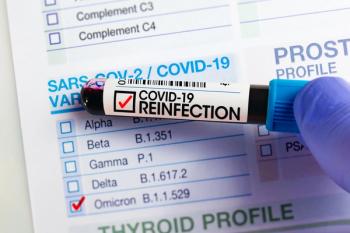
- September 2011 Pain Awareness
- Volume 77
- Issue 9
Pharmacists as Immunization Providers: Patient Attitudes and Perceptions
Community pharmacies are positioned to dramatically increase vaccine coverage for influenza, reducing the burden of the disease nationwide. For pharmacists to take the lead on vaccine administration, however, patients must be supportive of pharmacy-based primary care.
Introduction
According to Healthy People 2020, the US government recommends that by the year 2020, 80% of adults 18 to 64 years and 90% of older adults older than 65 years should be immunized for seasonal influenza.1 The definition of vaccination coverage is the percentage of persons in a population who have received at least 1 dose of influenza-containing vaccine in a given year.2 Coverage has improved in recent years, but remains well below targets. From 2008 to 2010, coverage improved from 25% to between 45% and 49% among adults, and between 39% to 72%, among older adults.3
The introduction of the novel H1N1 strain in 2009, the resulting vaccine shortage, and the subsequent risk prioritization of patients for vaccination complicated vaccine administration.4 These factors may have caused patient frustration or confusion regarding vaccine availability and also may have influenced vaccine coverage rates. Improving coverage is crucial to prepare for seasonal and pandemic influenza alike.5 Utilizing all community resources to increase vaccine coverage rates in a cost-effective manner may be beneficial across the country.
To achieve the recommendations set forth in Healthy People 2020, retail community pharmacies can provide a significant venue to increase vaccination rates. There are 238,734 licensed pharmacists working in approximately 70,000 pharmacies across the United States.6 Pharmacies are open longer hours when compared with most primary care clinics, so they can provide a convenient platform for vaccination in addition to traditional channels (eg, physician offices and public health departments).
A recent survey of public health leaders5 identified pharmacists as playing a key role in vaccine administration and pandemic planning. Evidence in published medical literature suggests that pharmacies are uniquely positioned to influence previously difficult-to-reach populations.7-10 A review of pharmacy-led immunization programs11 concluded that pharmacies might be especially effective in immunizing high-risk, older adults who are more likely to need prescription medications and, therefore, use pharmacy services. Pharmacist interventions have been shown to improve medication adherence,12 provide increased access to health care expertise and advice,13 and perform a variety of primary care services.
Consumer acceptance of an expanded role of pharmacists into immunization services is necessary to increase access to preventive care and ultimately improve vaccination coverage.11 Measuring patient satisfaction is important to understanding patients’ acceptance of a shift from primary care providers to pharmacists as providers of immunization services and also to continue to broaden this access channel for immunizations overall. Accordingly, a study was undertaken to assess patient satisfaction with their influenza vaccination experiences at a large chain pharmacy.
Methods
An independent survey research vendor14 conducted a weekly telephonic consumer survey of patients who were 18 years and older and had received flu shots in the prior week at 1 of the more than 7500 Walgreens pharmacies nationwide. The survey instrument was developed by Directions Research, Inc and was administered via computer-assisted telephone interviewing (CATI). Weekly random samples of 20,000 patients were drawn; patients were called in random order until 100 patients were reached. After the first 2 weeks, the targeted number of surveys was increased to 250 surveys. Data from August 23, 2010, through January 24, 2011, were included in this analysis.
The survey contained more than 80 consumer-oriented questions, of which 7 key questions were selected that focused on patient satisfaction: 6 questions measured specific aspects of the immunization experience, and 1 question measured overall satisfaction. All responses were on a 1 to 9 scale, where 1 = Not at all Satisfied and 9 = Extremely Satisfied. The satisfaction scale was transformed into 3 categories: 1) dissatisfied; 2) neutral; and 3) satisfied—based on tertile distribution (ie, 1-3, 4-6, 7-9) of the scaled score. Therefore, patients were considered satisfied for any particular question if they selected 7, 8, or 9 on the scale.
Results
A total of 29,802 contacts were attempted. Of the 3293 patients who were reached via telephone, 2502 (8.4% of attempts; 75.9% of contacted) patients completed 1 or more of the key survey questions. Depending on the question, the number of missing or unknown values ranged from 1% to 9% (n = 5 to 217). Therefore, the satisfaction rate for every question calculated was based on complete responses. Age and gender was available for 2237 of the 2502 patients. The sample was predominantly comprised of women (70.4%; n = 1574) and persons 65 years and older (60.8%; n = 1361).
Ninety-seven percent (2413/2487) of patients were satisfied with their overall experience when receiving a pharmacist-provided influenza immunization. Responses pertaining to individual questions about professionalism, courtesy, helpfulness, advice, care, and knowledge were significantly correlated with overall satisfaction. The vast majority of patients were satisfied with the advice and counseling provided (95.2%; 2176/2285), the pharmacists’ knowledge (98.8%; 2404/2434), and believed that the pharmacist cared about them (97.2%; 2395/2464). The majority reported being satisfied with the professionalism (99.1%; 2469/2492), courtesy/friendliness (98.8%; 2459/2489), and helpfulness (98.9%; 2448/2475) of the pharmacist administering the immunization.
Discussion
Measuring patient acceptance of pharmacists as immunizer is an important step to expanding their role. Ensuring and monitoring patient satisfaction with pharmacy-based vaccination services will assure that this new channel for improving immunization coverage will be successful. The results of this survey suggest that patients are satisfied with their immunization experience at pharmacies. These results are consistent with other studies in the published medical literature that assessed patient satisfaction with pharmacy-based immunization initiatives.
For example, a survey in Claremont, California,15 found that 96% of patients who attended a pharmacist-run travel vaccine clinic were satisfied with the level of care. A survey of patients served by the Veterans Affairs San Diego Healthcare System (VASDHS)16 noted that 86.9% of patients were reported as satisfied (ie, top 2 categories of satisfaction in a 5-point Likert scale) with pharmacy-based immunization clinics. Comparison with previous studies was limited by methodologic differences such as survey instruments, sample period, and scale. However, these results collectively affirm that pharmacy-based influenza vaccinations are well received by patients.
Patient satisfaction as a measure of perceived quality of care is often used as a proxy quality indicator.17,18 Research has shown patient satisfaction to be positively correlated with continuity of care, which has been shown to improve clinical outcomes.19,20 This study also noted a correlation between provider interactions (eg, friendliness, courtesy) and patient satisfaction. As with physician continuity, promotion of an ongoing relationship between a patient and pharmacist could improve clinical outcomes if such social support improved adherence to preventive care, such as vaccinations.
As is common in patient satisfaction research,17 survey results were skewed toward high satisfaction and yielded a significant interscale correlations. Larson, Rovers, and MacKeigan21 reasoned that, given a tendency for positive responses, focusing on patient dissatisfaction outliers rather than the satisfied majority might be more meaningful for the evaluation of outcomes. Accordingly, only 0.8% (20/2487) of patients rated dissatisfied in the overall line of questioning. Many factors not associated with quality of care, such as the patient’s current state of health, expectations of care, and personal preferences, can influence patient satisfaction.22 Patients’ state of health at the time of survey could negatively affect satisfaction. For example, a study by Lis23 found that fatigue was highly predictive of care satisfaction. In contrast, higher patient satisfaction is associated with older patients.17 Strengths of the current study included a robust sampling frame, independent evaluation, and a short sampling period.
Limitations
Limitations of the study included a high rate of “unable to reach” via telephone, use of a nonvalidated instrument, and lack of a comparison group. First, low contact rates are a common limitation of CATI surveys, so extrapolation of results to populations that are traditionally hard to reach by telephone is cautioned. Still, once contact was established, the majority of individuals completed the survey. Second, this study used a nonvalidated instrument, so a recommendation for future research is validation of the survey instrument. Several health quality organizations, such as Agency for Healthcare Research and Quality (AHRQ)18 have developed standardized or validated survey tools to assess satisfaction in hospitals, home health, and hemodialysis, but not pharmacy services. Therefore, studies that validate satisfaction instruments for pharmacy services quality would be valuable. Finally, the current study design did not allow for a direct comparison group of satisfaction with other channels of vaccine delivery.
As an external benchmark, the AHRQ recently released a preliminary report of the Consumer Assessment of Healthcare Providers and Systems Program (CAHPS), which measures patient satisfaction with outpatient services.18 The proportion of patients reporting the highest levels of satisfaction with primary care providers ranged from 75% to 81%. Although the present study and the CAHPS study used a similar “top box” approach, where the upper tertile of the satisfaction scale reflected satisfaction, the CAHPS satisfaction scores were lower. Direct comparison between these studies should be tempered due to differences in the patient demographics and the survey instrument.
For example, lower patient satisfaction has been associated with younger patients,17 and the CAHPS sample of patients was considerably younger (65 : 21% to 48%) when compared with the current sample (65 : 60%). Compared with preventive care services such as immunizations, primary care services would have a greater proportion of ill patients seeking care. These patients would likely be in a poor state of health, which is associated with lower patient satisfaction.19Additionally, the CAHPS study assessed across health organizations, which would likely have greater variability in quality of care than a single, large health provider. Use of a common, validated satisfaction instrument would be necessary to have better comparisons of immunization satisfaction across settings.
Conclusion
Influenza remains a significant public health burden, and increasing immunization coverage continues to be a challenge for the US health system. Community pharmacies are uniquely positioned to meet this challenge. The role of pharmacists as health care providers continues to evolve as they take full advantage of all the capabilities that come with their clinical training. Patient acceptance of the expanded role of pharmacist providers may be influential in increasing capacity and access to primary health care.
All authors are employed by Walgreens. Dr. Taitel is director of health outcomes & analytics; Dr. Cohen is pharmacy services senior business manager, immunization clinical services; Ms. Terrranova is project manager, healthcare insights; Ms. Baloun is consumer research consultant, healthcare insights; Ms. Kirkham issenior analyst, health outcomes & analytics; Mr. Duncan is vice president, clinical outcomes & analytic services; and Dr. Pegus is chief medical officer.
References
- US Department of Health and Human Services. Healthy people 2020. www.healthypeople.gov/2020/default.aspx. Accessed April 10, 2011.
- WHO Statistical Information System (WHOSIS). www.who.int/whosis/indicators/2007Immunized/en/index.html. Accessed April 10, 2011.
- Setse RW, Euler GL, Gonzalez-Feliciano AG, et al. Influenza vaccination coverage United States, 2000-2010. MMWR. 2011;60:38.
- Poland GA. The 2009-2010 influenza pandemic: effects on pandemic and seasonal vaccine uptake and lessons learned for seasonal vaccination campaigns. Vaccine. 2010;28:D3-D13.
- Rambhia KJ, Watson M, Sell TK, Waldhorn R, Toner E. Mass vaccination for the 2009 H1N1 pandemic: approaches, challenges, and recommendations. Biosecur Bioterror. 2010;259-263.
- US Department of Health and Human Services. U.S. Health Workforce Personnel Factbook. http://bhpr.hrsa.gov/healthworkforce/reports/factbook.htm. Accessed April 10, 2011.
- Crawford N, Blaney S, Amesty S, et al. Individual- and neighborhood-level characteristics associated with support of in-pharmacy vaccination among ESAP-registered pharmacies: pharmacists’ role in reducing racial/ethnic disparities in influenza vaccinations in New York City. J Urban Health. 2011;88(1):176-185.
- Hogue MD, Grabenstein JD, Foster SL, Rothholz MC. Pharmacist involvement with immunizations: a decade of professional advancement. J Am Pharm Assoc. 2006;46(2):168-182.
- Uscher-Pines L, Maurer J, Kellerman A, Harris KM. Healthy young and middle age adults: what will it take to vaccinate them for influenza? Vaccine. 2010;26(46):7420-7422.
- Westrick SC. Pharmacy characteristics, vaccination service characteristics, and service expansion: an analysis of sustainers and new adopters. J Am Pharm Assoc. 2010;50(1):52-61.
- Francis M, Hinchliffe A. Vaccination services through community pharmacy: a literature review. Public Health Wales NHS Trust; 2010.
- Jiang JZ, Khandelwal N, Frazee SG, Nadas J. PHP54 Study: the impact of autorefill program on medication adherence. Value Health. 2010;13(3):A91.
- Patwardhan A, Davis J, Murphy P, Khandelwal N, Sherman B, Manfred J. The impact of 90-day prescriptions on adherence at workplace pharmacies compared to traditional mail order. Popul Health Manag. In press.
- Directions Research Inc. www.directionsresearch.com/privacy.html. Accessed April 10, 2011.
- Hess KM, Dai CW, Garner B, Law AV. Measuring outcomes of a pharmacist-run travel health clinic located in an independent community pharmacy. J Am Pharm Assoc. 2010;50(2):174-180.
- Bounthavong M, Christopher MLD, Mendes MAS, et al. Measuring patient satisfaction in the Pharmacy Specialty Immunization Clinic: a pharmacist run immunization clinic at the Veterans Affairs San Diego Healthcare System. Int J Pharm Pract. 2010;18(2):100-107.
- Sitzia J, Wood N. Patient satisfaction: a review of issues and concepts. Social Science & Medicine. 1997;45(12):1829-1843.
- US Department of Health and Human Services. Preliminary comparative data for the CAHPS clinician & group survey (12-month version). www.cahps.ahrq.gov/content/ncbd/pdf/ClinicianGroupPreliminaryReport11_2010.pdf. Accessed April 10, 2011.
- Saultz JW, Albedaiwi W. Interpersonal continuity of care and patient satisfaction: a critical review. The Annals of Family Medicine. 2004;2(5):445-451.
- Sudhakar-Krishnan V, Rudolf MCJ. How important is continuity of care? Arch Dis Child. 2007;92(5):381-383.
- Larson LN, Rovers JP, MacKeigan LD. Patient satisfaction with pharmaceutical care: update of a validated instrument. J Am Pharm Assoc. 2002;42(1):44-50.
- Kane RL, Maciejewski M, Finch M. The relationship of patient satisfaction with care and clinical outcomes. Med Care. 1997;35(7):714-730.
- Lis CG, Rodeghier M, Grutsch JF, Gupta D. Distribution and determinants of patient satisfaction in oncology with a focus on health related quality of life. BMC Health Serv Res. 2009;9(1):190.
Articles in this issue
about 14 years ago
Opioids in an Era of Shifting Attitudesabout 14 years ago
The Pharmacist as Heroabout 14 years ago
Can You Read These Rxs?about 14 years ago
Case Studiesabout 14 years ago
Hospital Pharmacies Need Better Automated Toolsabout 14 years ago
Insulin Pump Hacking Unlikely, Says Medtronicabout 14 years ago
Rare Disease Research Goes Viralabout 14 years ago
Technology Product NewsNewsletter
Stay informed on drug updates, treatment guidelines, and pharmacy practice trends—subscribe to Pharmacy Times for weekly clinical insights.


















































































































































































































